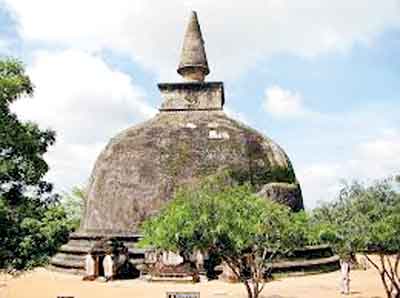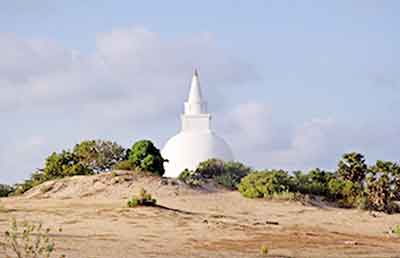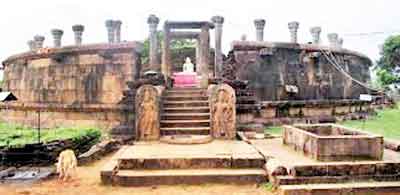Head to the East for a feast of archaeological sites

Kuchchaveli Rajamahavihara
The lifelong ambition of our grandfathers and grandmothers was to do the Buddhist circuit, popularly known as the Watavandanawa.It is said that before they left on pilgrimage they gave over all their movable and immovables to their next of kin. At a time when there were no proper roads and no means of transport it was a hazardous trip and hence, no surprise that they did so.The main mode of transport was the bullock cart.
R. Chandrasoma of the former Ceylon Civil Service who was on official duty, describes his trip from Tissa to Kataragama in the following words. “In places, the gradient, the terrain, stumps, stones, and declivities together with the danger of meeting wild animals made the cart journey, bone- shaking and hazardous.” This was only a short trip of 25 kilometres. Visits to Anuradhapura or Seruwila were more time-consuming and more dangerous. There were seven ferries before one reached Seruwila. More recently, the danger of terrorist attacks loomed large over the pilgrims, restricting their movements further.
With the elimination of the terrorist threat, the improvement of road and transport systems and availability of other facilities such as accommodation, more and more pilgrims have started to visit the sacred places, particularly of Anuradhapura and Polonnaruwa. Now, pilgrims can visit Anuradhapura, worship at the eight sacred places and return to Colombo the same day.
However the end of the war did not have the same effect in the East, although like a necklace studded with pearls, a series of archaeological sites exist along the Eastern coast, some dating back to pre-Christian times.
Lithic, archaeological and literary evidence establish the fact that this area had a thriving prosperous population by the 1st century A.D.Prof.Paranavitana in his publication “Early Brahmi Inscriptions,(1-3rd centuries) ” cites 179 inscriptions from the three districts of Amparai, Batticaloa and Trincomalee. Over the centuries, some of these sacred places have been subject to destruction by foreign invaders, sea erosion, encroachers and treasure hunters. But there are still many which await the archaeologist’s attention.

Mudumaha viharaya
On the East coast of the Island from Arisimale on the northern boundary of the Trincomalee District to Pottuvil in Ampara District, over a dozen little known archaeological sites, some dating to pre-Christian era exist having survived the onslaughts of invaders, encroachers, treasure hunters and the sea over the years.
Arisimale:
At the northern-most point of the Trincomalee district, 60 kilometres from the town is Arisimale.It is believed that Thapassu and Bhalluka, the two merchants who received a lock of hair from Buddha had landed at Arisimale Beach from where they travelled up to Tiriyaya to deposit it in a shrine.
Tiriyaya :Girihandu chaitya
Tiriyaya is situated south of Arisimale near the sea coast, 36 kilometres from Trincomalee.The summit has a vatadage round which are concentric circles of graceful pillars. About 100 metres away was found an inscription composed in Sanskrit which mentions that Girikandicaitya was founded by the merchants named Thapassu and Bhalluka.They are considered as the first among the Buddha’s lay disciples who offered food to the Buddha immediately after his enlightenment. The two brothers had come to Sri Lanka and when they came to Girihandu they placed the casket with the Buddha’s relics on the summit of the rock and were unable to remove it. They knew that it was a holy place and after building a stupa offered flowers and went their way.
Kuchchaveli Rajamaha vihara:
Thirty one kilometres toTrincomalee and twelve kilometres south of Tiriyaya along the beach is Kuchchaveli Rajamaha viharaya.
The sea has eaten into most of the temple but there are still a few ruins at the site. There is a cluster of gneiss boulders among which are several rock caverns of various shapes. Among them is the engraving of 16 stupas on the face of a rock on a panel of 4’x4’ neatly divided into 16 squares. To the left of this sculpture is an inscription which is considered the earliest Sanskrit inscription known in Sri Lanka belonging to the 7th century.The author wishes that by the merit he has gained he may become a Buddha in a future birth
Velgamvehera:
Velgamvehera is about 10 kilometres to the N.W of Trincomalee.Spread over the temple premises are a number of archaeological remains which include among others, three stupas, a main shrine room, reclining Buddha shrine room, a pond and other artifacts.Velgamvehera is important as one Buddhist temple which had been substantially influenced by Hindus.There are fragments of about 18 Tamil inscriptions dating from the time of Raja raja I and Rajaraja II. Also the main shrine room indicates the characteristics of Dravidian architecture.
Gokanna Viharaya
Trincomalee had been known as Gokanna in ancient times. According to the Mahavamsa and the Chulavamsa the GokannaVihara was built by King Mahasen in the 3rd century (275-301 AD) by destroying a Jaina monastery that existed on the summit of the Rock, where the Koneswaram Kovil stands today. It is said that in the reign of King Agbo V, the temple was modified by adding a preaching hall.
The temple was destroyed in 1724 A.D by the Portuguese general Constantine De Saa to construct a fort there. According to the Portuguese historian De Queyroz, the GokanaVihara was a Buddhist temple until it was destroyed by the Portuguese in the 16th century.
Today GokannaViharaya at the bottom of the rock seems to be what is left of the ancient temple.
Seruvila Rajamaha viharaya:
Seruvila Rajamaha viharaya is 38 kilometres from Trincomalee on the Muttur–Verugal road.Ven .Dambagasare Thera from the south of Sri Lanka after re-discovering the dagaba and assisted by the Archaeological Department, restored the stupa using remains of ancient structures around the stupa to conjecture the conservation work.
According to Dhatuvamsa written in the 13th century, King Kavantissa during the latter part of his reign travelled from Magama and constructed the stupa with the support of local rulers.The Dhatuvamsa states that the Buddha’s collar bone was enshrined here. After completion of the stupa he made arrangements for its upkeep and returned to Magama.

Girihandu chaitya
Lanka Patuna:
Lanka Patuna is situated 50 kilometres south of Trincomalee and is the place Princess Hemamali and Prince Danta landed bringing the Sacred Tooth Relic (Danta- dhatu) from Kalinga in the reign of King Meghavanna in about 320 A.D. The arrival of the Danta -dhatu is an important landmark in Sri Lankan history. This Sacred Relic in the course of time not only became an object of the utmost religious importance but also the palladium of the Sinhala state, a position which persists to date.
Lanka Patuna had been occupied by the terrorists after the viharaya was destroyed to put up a transmission station. But after the defeat of the LTTE a new stupa has been constructed.
Pashana Pabbatha Rajamaha viharaya:
Sixty kilometres fromTrincomalee the little known Pashana Pabbatha Rajamaha viharaya located close to Verugal Aru, according to an inscription found there, had been built over 2000 years ago by King Mahadathika Mahanaga (9-21AC) of the Anuradhapura Kingdom. There are six inscriptions carved in ancient Brahami script referring to a flourishing commercial civilization in the East.One of the inscriptions refers to a deposit of 500 gold coins (kahapanas) by a minister named Rakha who wanted the interest from the deposit to go the temple for its mainatence.
A number of inscriptions with this king’s name have been found in several places in the Eastern Province of the country located close to the sea. The king had exempted temple lands from the land tenure which had been imposed on the people of the area. Situated on a rocky outcrop with a commanding view of the surrounding area, the terrorists had used this site to have their eastern radio transmission station.
Mudumaha viharaya:
Mudumaha viharaya is situated 245 kilometres from Trincomalee near a wide beach and has been built over 2000 years ago by King KavanTissa of Ruhuna. Some of the ruins have been destroyed by some local encroachers. During British times it seems it had nearly 260 acres but now has been restricted to a few acres. Some believe that Viharamahadevi landed here although there are some who think that she landed at Kirinda, further to the south.
Dhammadeepa Stupa:
The latest addition to this string is a new stupa built on a hill top in SamudrasannaVivekaramaya at Kinniya, Trincomalee at the request of the people of the area by the devotees of Narada Dhammayatanaya, Bauddhaloka Mawatha, Colombo under the patronage of Venerable Panditha Talalle Chandakitti Thera, the Viharadhipati. The most Ven. Tirikunamale Ananda Mahathera the Mahanayaka of Dharmarakkhita Amarapura Nikaya graced the occasion when it was bequeathed to the Buddha Sasana recently. The stupa named Dhammadeepa can be seen from air, sea and land and has a dominant and fascinating view from all three directions and also from the summit of the hilltop.
Other places of interest in the East:
Though not by the sea there are number of other key archaeological sites a little inside and close to Amapara town. Among them are Dighavapi ,Raja gala and Buddhangala, all dating back to pre-Christian times. Similarly a few kilometres away from Pottuvil are located, Nilagiri Viharaya and Magulmal viharaya, all in the Ampare District .
The three districts of Trincomalee, Batticaloa and Amparai which make up the current Eastern Province formed part of the ancient Rohana (Ruhuna?).The archaeological evidence, lithic records ,and literary evidence indicate the existence of well-developed settlements in the East and South West of the Island with Magama as the capital. Prof Paranavitane in his publication, “Early Brahmi Inscriptions for the period 3rd century B, C to 1st century A.D” identifies 179 cave inscriptions in these three districts.
The elimination of terrorism paved the way for free movement of people across the island. For three decades Buddhists were prevented from travelling to Nagadeepa, one of the holiest places, and it was as if the flood gates were opened when they started to travel to Jaffna, most of them for the first time.Similarly, Hindus from Jaffna started to head towards Kataragama and started to mingle with the Buddhists at Kataragama worshipping the same God.
In spite of having a good network of roads there was no immediate interest from the South to visit the sacred places of the East. Few knew of the existence of so many important Buddhist places, only of Seruwila and Dighavapi but they alone were not an inducement to go that far. They were not aware of the historical and religious importance of some of these places; that the Buddha’s relics had been enshrined in Girihandu Chaitya, that Bhaddkaccayana, that the consort of Abhaya arrived at Gokanna, that the relics of Thera Mahinda are enshrined at Rajagala, that the relics of Sariputta and Moggallana Theras were found at Buddhangala and that Hemamali and Prince Danta landed at Lanka Patuna.
The time has come to draw the interests of Buddhists to the numerous Buddhist/archaeological sites in the East which they were not aware of and hence neglected, destroyed, encroached upon and eroded by the sea.They are all located along the East coast or a few kilometres away from it.The Mutur bridge opened the road all the way from Trincomalee to Seruwila.There are no more ferries to cross before one reaches Tiriyaya.The road to Lankapatuna is now motorable.
These are places unexplored by many and located along some of the most beautiful beaches of the island. An added bonus for the visitors will be the closeness to archaeological sites in Moneragala District, the Kumana bird sanctuary, Lahugala Kitulana national park, hot springs at MahaOya and Kinniya, Trincomalee harbour, Pasikudah and many more places of interest.A trip to the East could have a combination of religious, cultural, educational and leisure components, all in one package.


